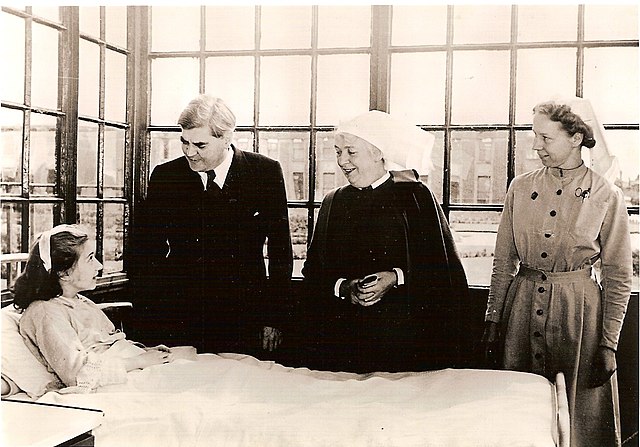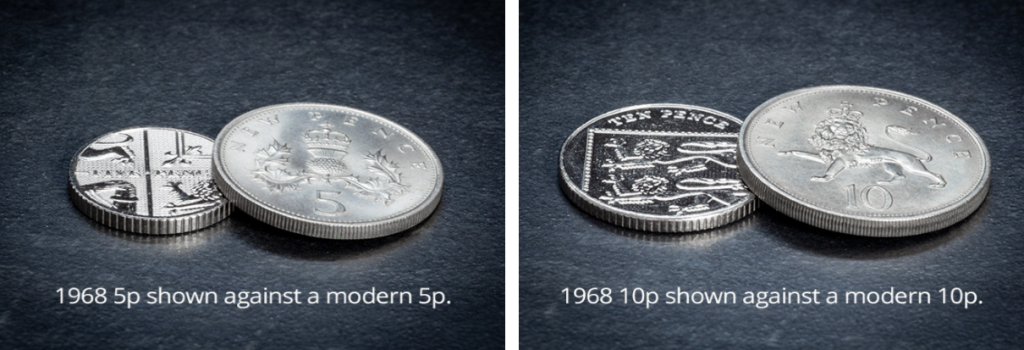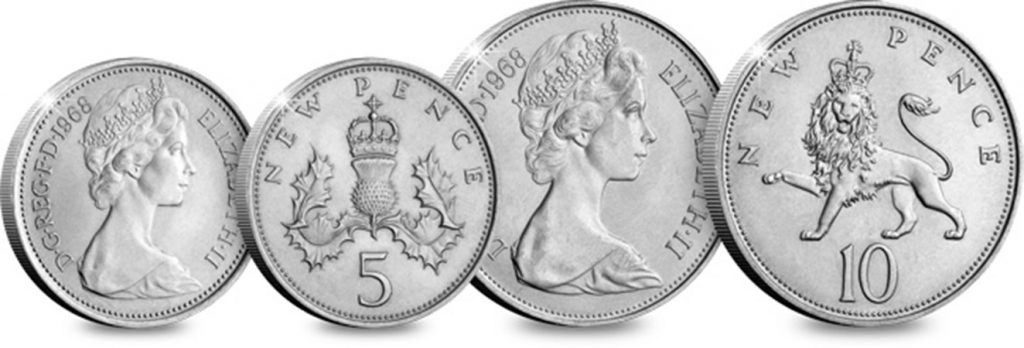Posts Tagged ‘Britain’
UK 50p celebrates 75 years of the NHS
2023 marks 75 years of our NHS, and to celebrate, a UK 50p was issued.
This coin may look familiar, and that’s because it featured in the 2023 Annual Coin Set released earlier this year, but now you can finally own it individually!
A closer look
The 2023 UK NHS 50p represents the nation’s appreciation for NHS workers and services, with an original design by Alice Lediard. The reverse design features key words associated with the NHS such as dedication, hope, support and compassion. The words ‘National Health Service 75’ can also be seen highlighted in the centre of the coin.
What’s more, The Royal Mint are donating 100% of the profit made from these coins to NHS Charities Together. Over 230 NHS Charities across the UK provide additional support and resources for both staff and patients.
What better way to say thank you for over 75 years or service.
The nation’s service
Since it was established in 1948, the National Health Service has played a pivotal role in the lives of the British public. It provides millions of people with vital care and medical services. This was especially apparent in recent years during the challenges of the Covid-19 pandemic.

University of Liverpool Faculty of Health & Life Sciences from Liverpool, United Kingdom, CC BY-SA 2.0, via Wikimedia Commons
Numismatic history of the NHS
This isn’t the first time the NHS has been celebrated on a UK coin…
1998 50th Anniversary of the NHS 50p
In 1998, a UK 50p was released to commemorate the 50th anniversary of the NHS.
The reverse design by David Cornell shows a pair of hands cupping rays of light along with the inscription ‘NHS FIFTIETH ANNIVERSARY’.
2018 A-Z ‘N’ NHS 10p
Almost 20 years later in 2018, the NHS 10p was released as part of the 26 coin A-Z 10p series.
The series celebrated all things British, so it’s no surprise that the NHS was chosen to represent the letter N. The reverse design shows a stethoscope wrapped around the letter N in the shape of a heart.
The A-Z 10ps have become some of the hardest UK circulation coins to find, with a mintage of only 304,000 per letter.
And that brings us to the 2023 75th anniversary of the NHS 50p, which you can own in brilliant uncirculated quality.
Secure your 2023 UK 75 Years of the NHS Certified BU 50p

Your 2023 UK NHS 50p is presented in official Change Checker packaging so it’s safely preserved for generations to come. Secure yours here >>
50 years since the most important moment in British numismatic history…
2018 marks the 50th anniversary of arguably the most important moment in British numismatic history – the first coins issued for decimalisation.
In 1968, the British public would have found 5p and 10p coins in their change for the very first time, issued as part of Britain’s conversion to a system of decimal currency.

1968 5p and 10p coins
The coins bore new heraldic designs, but were exactly the same size and value as shillings and florins, which meant the changeover process should have been a smooth transition. However, after generations of pounds, shillings and pence, the Decimal Currency Board still needed to reassure suspicious Britons to go decimal – a case which had actually been argued as long ago as 1696 by Sir Christopher Wren.

Advert from the Decimal Currency Board. Credit: Daily Mail
It was the 1960 report by the Association of British Chambers of Commerce and the British Association for the Advancement of Science which finally set into action a currency based upon simple multiples, a system already adopted by a number of Commonwealth countries including Australia, New Zealand and South Africa.
A massive number of coins were required for the changeover, forcing The Royal Mint to move location from Tower Hill to its new production facility in Llantrisant, South Wales, where the first of almost six billion coins required for decimalisation went into production.

The Royal Mint at Tower Hill, London. Credit: The Royal Mint museum
It was then on the 23rd April 1968 that the new 5p and 10p coins went into circulation, operating as legal tender up to the sum of £5, with mintage figures of 98,868,250 and 336,143,250 respectively.
The humble 5p featured the Christopher Ironside reverse design until 2008 and has since featured Matthew Dent’s reverse design, following a public competition held by The Royal Mint. On the 27th June 1990, a reduced size version of the coin was introduced and the older, larger coins were withdrawn on the 31st December 1990, although the design remained unchanged.
Similarly, the 10p coin also featured Christopher Ironside’s reverse design up until 2008 when this was replaced by Matthew Dent’s. However, the 10p remained a larger coin until the 30th September 1992, when the reduced size version was introduced, with the larger coin being removed from circulation a year later.

As we seem to move ever closer towards a cashless society, the questions lingers as to how long these decimalised coins will remain a necessity… However, this year’s release of 26 brand new A-Z of Great Britain 10p coin designs just goes to show that the demand for the smaller denomination coins is still there. In fact, these little coins have become incredibly sought-after and have dominated news stories and conversations amongst collectors, with everyone wanting to get their hands on the elusive coins!
Although the nation seemed reluctant to accept these decimal coins back in 1968, I think it’s fair to say that they have now become a much loved part of British coinage and as we celebrate the 50th anniversary of the first decimalised coins, we can look back with fondness for the 5p and 10p coins.
Own the very first coins issued for decimalisation!
The First Decimalised Coins include the original 5p and 10p coins from their first year of issue, 1968.
Order yours today to mark the 50th anniversary of the introduction of these significant coins >>
Britain’s top historical coins!
The coins we find in our change can act as a guide to map out our nation’s heritage, and these historical coins play an incredibly important role in preserving these key moments for generations to come.

We put together a list of our top ten historical coins and asked Change Checkers to vote for their all time favourite, read on to find out more about these coins and to find out which was voted your favourite!
10. 2005 Gunpowder Plot £2 – 2% of votes
Theme
In 1605, a failed assassination attempt of King James I by a group of English Catholics went down in history as The Gunpowder Plot. Whilst the 5th of November is now an an exciting celebration with fireworks and bonfires, the plan made by these rebels back in 1605 was far less light hearted…
They plotted to blow up the House of Lords during the opening of Parliament on 5th November 1605, but Guy Fawkes was discovered the night before, guarding 36 barrels of gunpowder and was subsequently executed along with seven other plotters.
Coin Design
In 2005, The Royal Mint issued this £2 coin to mark the 400th anniversary. The reverse design of this coin features a montage of bishop’s crosiers, swords, and the Parliamentary mace – symbolising the survival of the British establishment.
Circulating Mintage – 5,140,500
Scarcity Index Rating – Common
9. 2016 Battle of Hastings 50p – 5% of votes
Theme
In 1066, King Harold II’s English army was defeated by the Norman-French army of William the Conqueror. This led to the Norman conquest of England, with William the Conqueror becoming our first Norman King – a crucial moment in medieval history.
Coin Design
In 2016, The Royal Mint issued this 50p coin to mark the 950th anniversary of this hugely significant event, which changed the course of history. The reverse of this coin was designed by John Bergdahl and is inspired by the Bayeux Tapestry. It depicts the fate of King Harold at the hands of William The Conqueror, along with the famous date 1066. The obverse features the fifth portrait of Queen Elizabeth II by Jody Clark.
Circulating Mintage – 6,700,000
Scarcity Index Rating – Common
8. 2014 First World War Kitchener £2 – 6% of votes
Theme
Horatio Herbert Kitchener, the British Secretary of War, became synonymous with the enlistment campaign when war was declared on 4th August 1914. Intuition told him that the war would last for several years and so he masterminded a recruitment campaign to build the largest volunteer army that Britain had ever seen and oversaw a significant expansion of material production to fight on the Western Front. On 5 June 1916, Kitchener died aboard HMS Hampshire, when it struck a German mine near Scotland and sank.
Coin Design
To mark the centenary of the First World War, the Royal Mint revealed a five-year commemoration of the wartime journey from outbreak to armistice. and the first coin in the series is this £2 bearing a depiction of Lord Kitchener’s famous call to arms alongside the words YOUR COUNTRY NEEDS YOU.
Circulating Mintage – 5,720,000
Scarcity Index Rating – Common
7. 2005 End of World War II £2 – 7% of votes
Theme
The 8th May 1945 is known as VE Day – Victory in Europe, which marked the end of World War Two. This followed Germany’s surrender, about a week after Adolf Hitler had committed suicide during the Battle of Berlin.
Upon Germany’s defeat, an eruption of celebrations swept across the western world and in the UK, more than a million people took to the streets to mark the end of war. In London, King George VI and Queen Elizabeth appeared on the balcony of the palace alongside Prime Minister Winston Churchill, to stand before the cheering crowds.
Coin Design
The reverse design of this £2 features a depiction of St Paul’s Cathedral which survived the Blitz and became a great symbol of hope to a war-torn nation. The edge inscription reads – IN VICTORY: MAGNANIMITY, IN PEACE: GOODWILL – part of the famous maxim that prefaces Churchill’s history of the Second World War.
Circulating Mintage – 10,191,000
Scarcity Index Rating – Common
6. 1998 NHS 50p – 7% of votes
Theme
On the 5th of July 1948, the National Health Service was born – providing a health service available to all and financed entirely from taxation. After a Labour victory in the 1945 general election, Aneurin Bevan became minister of health, responsible for establishing the NHS.
This was the first time that anywhere in the world had completely free healthcare for citizens and brought together hospitals, doctors and nurses as one service, becoming the third largest employer in England.
Coin Design
In 1998, The Royal Mint issued this 50p coin to commemorate the 50th Anniversary of the NHS. The coin’s reverse design features a pair of hands radiating lines to symbolise hope, created by David Cornell. This was the 3rd 50p in the smaller specification ,introduced in 1997, to enter circulation, preceded only by the Britannia 50p and the UK Entry to EEC 50p.
Circulating Mintage – 5,001,000
Scarcity Index Rating – Less Common
5. 2003 Suffragettes 50p – 8% of votes
Theme
With Emmeline and Christabel Pankhurst at its forefront, the Suffragette movement finally saw the partial votes for women in 1918, with the franchise being extended to all women over 21 in 1928. The passionate campaigning for equal voting rights by this pioneering group of women meant that they risked ridicule and even imprisonment in defence of their cause. However, the foundations they laid shaped society’s idea of women and sparked a new era of feminist history.
Coin Design
The Royal Mint issued the Suffragettes 50p in 2003 to commemorate the centenary of the establishment of the Women’s Social and Political Union. The design, by Mary Milner Dickens, features the figure of a suffragette chained to railings holding a banner on which appear the letters WSPU and to the right a ballot paper marked with a cross can be seen.
Circulating Mintage – 3,124,030
Scarcity Index Rating – Less Common
4. 2009 Charles Darwin £2 – 10% of votes
Theme
Charles Darwin has been described as one of the most influential figures in human history and was known as the ‘father or evolution’. Born in 1809, Darwin was a British scientist whose work laid the foundations of the theory of evolution and natural selection, forever transforming the way we think about the natural world.
At the time of publication in 1859, his book ‘On the Origin of the Species’ was extremely controversial as it made it seem possible that humans evolved from apes, contradicting the widely held Orthodox Church theory of creation.
Coin Design
His death on the 19th April 1882 was honoured with a burial at Westminster Abbey and in 2009, The Royal Mint celebrated 200 years since his birth and 150 years since the publication of ‘On the Origin of Species’ with this £2 coin. The reverse design by Suzie Zamit features a profile portrait of Darwin facing a chimpanzee.
Circulating Mintage – 3,903,000
Scarcity Index Rating – Less Common
3. 2015 Magna Carta £2 – 14% of votes
Theme
The Magna Carta or ‘Great Charter’ is known as one of the most famous documents ever written and forms the foundations for modern democracy and the rights of all English citizens today. Issued in 1215 by King John of England (otherwise known as ‘Bad King John’ due to his autocratic rule), the charter made peace with the rebel barons who had been causing a political crisis and stated that everyone (including the king) was subject to the law.
It’s still cited in many legal cases to this day and some of the core values can also be seen in the United States Bill of Rights (1791), despite the document being substantially altered within just 10 years of it being issued.
Coin Design
In 2015, The Royal Mint issued this £2 coin to celebrate the 800th anniversary of the Magna Carta. The reverse design of this medieval-style coin features King John holding a quill and flanked by two noblemen.
Circulating Mintage – 1,495,000
Scarcity Index Rating – Less Common
2. 2016 Great Fire of London £2 – 18% of votes
Theme
The Great Fire is one of the most well-known disasters to hit London, when an accidental spark from a baker’s oven on Pudding Lane led to the destruction of a third of the city. At the time, London had an estimated half a million inhabitants, many of which lived in wooden houses and makeshift structures that had become bone dry during an exceptional drought. Over the course of 4 days, flames reaching temperatures of 1,250 °C consumed 13,200 houses, 87 parish churches, St Paul’s Cathedral, and most of the buildings of the City authorities.
Coin Design
This 2016 £2 coin was issued by The Royal Mint to mark the 350th Anniversary of the poignant moment in the city’s history from which modern London emerged. The reverse depicts the city of London burning in flames from a distance and was designed by Aaron West.
Circulating Mintage – 1,625,000
Scarcity Index Rating – Less Common
1. 2018 Sir Isaac Newton 50p – 23% of votes
The 2018 Sir Isaac Newton 50p was voted a Change Checkers’ all time favourite historical coin!
Theme
Sir Isaac Newton is widely recognised as one of the most influential scientists of all time and a key figure in the scientific revolution. According to the Julian calendar in use in England at the time, Newton was born on Christmas Day, 25 December 1642, in the county of Lincolnshire. He became a fellow of Trinity College and the second Lucasian Professor of Mathematics at the University of Cambridge. His works changed our understanding of mathematics and physics and redefined the way we see the world.
In 1696, on the recommendation of the Chancellor of the Exchequer, Sir Isaac Newton became master of The Royal Mint, where he shaped the security of our currency, ensuring coins were made of the correct weight and fineness, varying as little as possible one from another.
Coin Design
Designed by Aaron West, this 50p coin was issued by The Royal Mint in 2017 to commemorate the achievements of Sir Isaac Newton and remember the legacy he left.
Circulating Mintage – 1,801,500
Scarcity Index Rating – Less Common
I’m sure you’ll agree that each of these historical coins beautifully represent a very special part of British heritage and acts as a window into our past history.
Do you agree with the vote results? If not, let us know in the comments which of these coins is your favourite!
Find out more about your coins

Download the FREE Change Checker Web App to find out more about the coins in your change.















